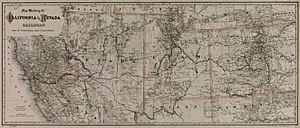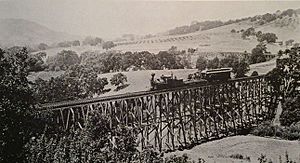California and Nevada Railroad facts for kids

The planned railroad, and its extensions and connections, 1882. Only the western 22 miles were actually built.
|
|

Trestle bridge of California and Nevada Railroad
|
|
| Overview | |
|---|---|
| Headquarters | 40th Street/San Pablo Avenue, Oakland, California |
| Locale | East Bay, California |
| Dates of operation | 1884–1903 |
| Technical | |
| Track gauge | 3 ft (914 mm) |
The California and Nevada Railroad was a special kind of train line. It was a 3 ft (914 mm) narrow gauge steam railroad. This means its tracks were closer together than regular train tracks. It ran in the East Bay area of San Francisco Bay Area in the late 1800s.
The company started on March 25, 1884. J.S. Emery was the railroad's president. The city of Emeryville is named after him. By March 1, 1885, the tracks were finished between Oakland and San Pablo, going through Emeryville. The tracks reached Oak Grove (now El Sobrante) on January 1, 1887.
Contents
The First Railroad: California & Mt. Diablo
The first 10 miles (16 km) of the California and Nevada Railroad were built by an earlier company. This company was called the California & Mt. Diablo Railroad. It was formed on March 21, 1881, in Emery's, which later became Emeryville.
This railroad also used 3 ft (914 mm) narrow gauge tracks. It started at 40th Street and San Pablo Avenue. The tracks went north for about 9.85 miles (15.85 km). They passed through areas that are now Berkeley, Albany, El Cerrito, and ended in Richmond.
Big Plans for the Railroad
The California & Mt. Diablo Railroad had very big plans. They wanted to build tracks from a pier in Emeryville on San Francisco Bay. Then, they planned to go all the way across central California. Their route would even cross the Sierra Nevada mountains. They hoped to connect with another railroad in Utah.
However, these big plans never fully happened. The California and Mt. Diablo company was later sold to the California and Nevada Railroad.
Reaching Orinda
The California and Nevada Railroad reached San Pablo, California in 1886. It was then extended further. The tracks went around the northern end of the Berkeley Hills and the San Pablo Ridge. Then, they turned southeast into the valley of San Pablo Creek, reaching Orinda. The tracks followed what is now the eastern shore of San Pablo Reservoir.
The railroad faced problems like not having enough money. Also, tracks often got washed out by floods. These issues stopped them from building more lines. For most of its time, the railroad was mainly used for fun weekend trips. The railroad reached Orinda in November 1891. This was its furthest point. At this time, it had 22 miles (35 km) of track.
End of the Line
The railroad ran into financial trouble. It was put into receivership (meaning a court took control of its finances) twice. This happened on May 29, 1896, and again on July 12, 1899. After 1900, the railroad stopped running trains. The company was sold in a foreclosure sale on November 29, 1902.
New Owners: Oakland & East Side Railroad
The pier that the California and Nevada Railroad had started building in San Francisco Bay was bought by "Borax" Smith. He used it to build a large causeway and ferry pier for his Key System interurban railway.
On March 7, 1903, a new company called the Oakland and East Side Railroad bought the old California and Nevada tracks. This company was working for its parent company, the Atchison, Topeka and Santa Fe Railway. Santa Fe wanted these tracks to get its trains into Oakland from its main station in Richmond, California.
The tracks beyond Richmond (north of today's El Cerrito Del Norte BART Station) to Orinda were no longer used. In 1903, Santa Fe changed the narrow gauge tracks to standard track gauge. This made them the same width as most other train tracks. After this change, on May 16, 1904, the Oakland and East Side Railroad was leased to Santa Fe. On that same day, the first Santa Fe train traveled on the newly updated line.
Route of the Railroad
The California and Nevada Railroad passed through these places:
- Oakland
- Emerys (now Emeryville)
- Berkeley
- Albany
- El Cerrito
- Richmond
- San Pablo
- Oak Grove (now El Sobrante)
- Fargos
- Orinda Park
- Bryant (now Orinda)
What's Left of the Railroad Today
Today, you can still see parts of the old railroad route. The section from San Pablo to Orinda follows much of the San Pablo Dam Road through El Sobrante.
The Santa Fe train line between Richmond and Oakland was stopped in the early 1980s. This happened because Santa Fe got permission to use Southern Pacific Railroad's tracks nearby. The old Santa Fe line was then turned into the Richmond Greenway, a path for walking and biking.
The Ohlone Greenway also runs along the original California and Nevada route. This is between El Cerrito Del Norte Station and Albany. A bicycle path now follows where the tracks used to be. A BART train line also runs next to it, using part of the old railroad land. For a few years, both BART and Santa Fe trains ran side-by-side in this area.



